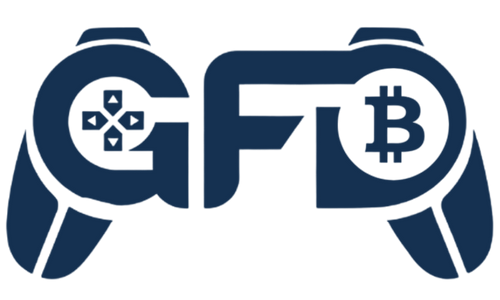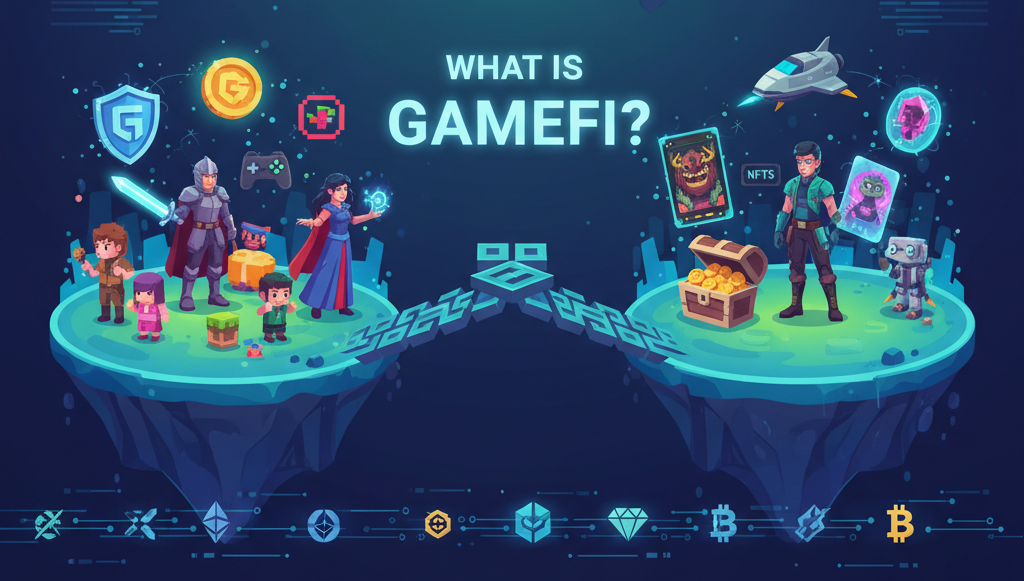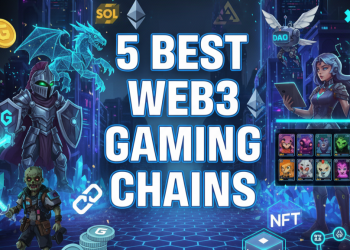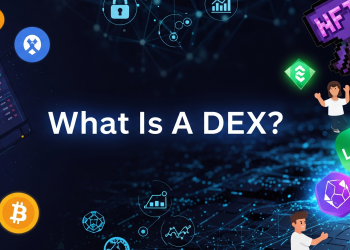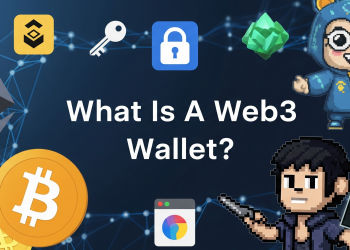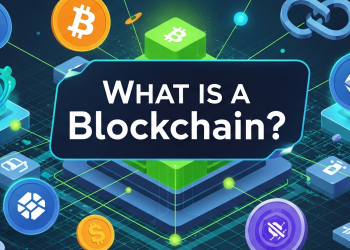GameFi (short for “Game Finance”) is the fusion of gaming and decentralized finance (DeFi), where players can earn, trade, and own digital assets through blockchain technology. Instead of game items staying locked inside a game’s servers, GameFi gives players true digital ownership of tokens, NFTs, and rewards.
What is GameFi?
GameFi combines the fun of video games with the earning and ownership features of DeFi.
- DeFi (Decentralized Finance) is the term used for financial services based on the blockchain, such as lending, staking, or trading, which do not involve banks.
- With DeFi integration in gaming, players are allowed to earn tokens, stake them for rewards, and treat NFTs as assets with real value.
Think of it like this: you are playing your favorite game and instead of only accumulating points, you are getting crypto tokens and items that are marketable, tradable, or even usable in other platforms.
How Does It Work?
GameFi combines the use of tokens, NFTs, and smart contracts to build a community-powered and player-owned economy.
Here’s the process:
- Players earn tokens by completing quests, battling, or trading.
- NFTs represent in-game assets, such as characters, land, or skins. These can be bought, sold, or rented out.
- Smart contracts enforce the rules, automatically distributing rewards or handling trades without a middleman.
| Component | How It Works in GameFi | Example |
| Token | Acts as in-game currency, rewards, or governance | $AXS (Axie Infinity), $SPINFUN (SpinCity Tycoon) |
| NFT | Represents characters, land, skins, or items that players truly own | Pixels land plots, Axie creatures |
| Smart Contract | Automates gameplay mechanics and secure transactions | Ronin blockchain contracts |
The Evolution of GameFi
GameFi didn’t appear overnight. It evolved in three key waves:
- Early Experiments (2017–2019): CryptoKitties showed NFTs could be digital pets.
- Play-to-Earn Boom (2020–2021): The growth of Axie Infinity was phenomenal, particularly in places like the Philippines, where the players made a daily income by playing the game.
- Web3 Expansion (2022–Now): Pixels and Star Atlas are two games that have changed the focus from profit-first to fun-first, with the addition of stable economies and stronger gameplay.
Why is It Different from Traditional Gaming?
GameFi differs from conventional gaming in a way that it grants players digital ownership of assets via blockchain, whereas traditional gaming does not.
Here’s the breakdown:
- 🎮 Traditional Games: The items that you have in your game are inaccessible and stored on the servers only. You can purchase different skins for your character, but you are not allowed to sell them anywhere outside the game.
- 🌐 GameFi Games: NFTs are the assets that depict the games, and the players are their owners. Players are free to trade these assets, use them on different platforms, and even take a profit out of them.
Benefits of GameFi
The benefits of GameFi extend to creating a new player-driven economy that goes beyond just entertainment.
- Ownership: The in-game items you have are yours, not the game developer’s.
- Earning Potential: The tokens and NFTs you have could be sold for real money.
- Community Driven: DAOs allow the community to vote on game changes and policies.
- Cross-Game Use: Some NFTs are compatible with multiple games.
Risks of GameFi
GameFi is exciting, but it also has potential risks that new users should be aware of:
- Volatility: Token prices can spike or crash at any time.
- Unsustainable Models: Quite a few of the first Play-to-Earn initiatives went down as their reward mechanisms were unable to sustain expansion.
- Scams & Hacks: Rug pulls and smart contract exploits remain a threat.
- Regulatory Uncertainty: Certain governments might consider gaming tokens as securities, which can have an impact on players and projects.
For beginners, it is advisable to first understand GameFi before making any investments.
Examples of GameFi Projects
- Axie Infinity (Ronin): The pioneer Play-to-Earn game, with NFTs called Axies.
- Pixels (Ronin): A farming and social metaverse game that lets players own land and create digital economies through it.
- Star Atlas (Solana): An online space strategy game/life metaverse where players can get NFTs of ships, land, and participate in space wars.
- SpinCity Tycoon (Solana): A casino management game where NFTs and tokens drive rewards, blending casual play with Web3 ownership.
The Future of GameFi
The GameFi future will be centered on Web3 ownership and players’ fun-first experiences. The players want games that can be fun and are not just profitable. So developers are creating sustainable tokenomics, more effective burn mechanisms, and casual mobile-friendly titles to satisfy that demand.
Besides, we will also witness deeper AI, metaverse platforms, and cross-chain ecosystem integrations. The latter means assets will be able to move from one game directly into another without any hassle. The final goal is a gaming environment where fun, ownership, and earning power are not at odds but complement each other.
FAQs
Q1: What is GameFi in simple words?
GameFi is gaming on the blockchain, where you can earn, trade, and own items as real digital assets.
Q2: Do I need crypto to play GameFi?
Some games are free-to-play, while others require a wallet and starter NFTs.
Q3: Can you make money from GameFi?
Yes, but it depends on the game, market conditions, and time invested. Many projects now focus on fun and ownership instead of quick profits.
Q4: What blockchain is best for GameFi?
Popular chains include Solana, Polygon, Ronin, Abstract, Immutable, and BNB Chain.
Q5: Is GameFi safe?
GameFi carries risks like scams, volatility, and unsustainable models. Beginners should research projects and avoid investing more than they can afford to lose.

